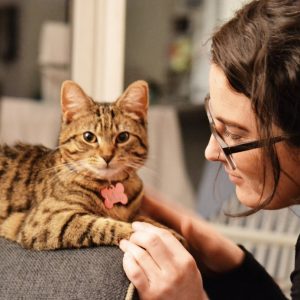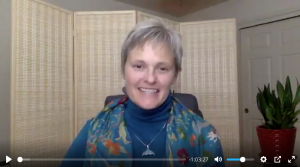 It’s an exciting time to be working in the field of Intuitive Interspecies Communication.
It’s an exciting time to be working in the field of Intuitive Interspecies Communication.
Fifteen years ago, when I first entered this field professionally, it was still considered “fringe”, a little “woo-woo”, and something that was interesting, but for the most part, definitely not worthy of serious scientific and academic study.
Coming from a background in both the arts and academia, I knew that bridging the divide between the academic, scientific, and intellectual worlds and the intuitive, telepathic, and spiritual worlds would not be easy.
What I did not know was how much of this gap would be bridged within my lifetime.
In every class I teach, every talk I give, I emphasize that telepathic/intuitive interspecies communication is not a “special gift” reserved for a very few people, but our birthright, a natural, universal language and way of knowing that is available to all beings, regardless of species. However, I am also aware of the extent to which so many of our human species remain cut off and separated from this knowledge, and this natural, innate way of listening, communicating, and understanding.
And yet, I have seen an exponential explosion in recent years of understanding, acceptance, interest, and respect in this field. The number of scientists, academics, veterinary professionals, medical doctors, researchers, engineers, and IT professionals who have shown up in my classes and training programs continues to expand. The separation, the split, is narrowing.
There is a growing awareness in people from all walks of life of the need to heal the separation of our species from the rest of world, and the imperative to understand and repair the damage that our disconnection and our forgetting has caused.
In the early years, when I would answer the question “So what do you do?” with a description of my work, people would be curious, but often mystified. Their point of reference was often the movie “The Horse Whisperer”, and they would say, “Do you mean like that?”
Skeptics would quickly change their tune when their animals told me things in great detail that there was no other way I could have known, but still, this was considered something kind of fringey, alternative, and a bit oddball…even if curious, accurate, and often useful. Sometimes people would tell me about interesting intuitive experiences they had had with their own animals, but often their curiosity would be limited to questions like, “Can you tell my dog to stop chasing the deer?”
Now, there is so much more awareness, understanding, and depth of perception about this way of communicating, understanding, and knowing. When I’m asked the same question now, people will often respond by sharing their experiences with their animal communicator, or stories of their own experiences of telepathic animal communication with companion and wild animals.
Just as modern neuroscience is now recognizing and illuminating the truths known by ancient cultures and teachings regarding our brains, our nervous systems, and our biology, so now is scientific and academic research shedding light on multiple ways of knowing that have been discounted in most of the dominant cultures and institutions of our world, including interspecies intuitive/telepathic communication.
We owe much of this to the trailblazers, both in interspecies communication and in science, as well as to the people in indigenous cultures throughout the world who never forgot, who have always lived, communicated, and understood in this way, and who kept this knowledge alive.
Biologists like Jane Goodall, Rupert Sheldrake, Mark Bekoff, and others, opened people’s minds and hearts to the consciousness and awareness of animals, and the possibility of connection and communication beyond mechanistic models. More recently, writers and scientists such as Robin Wall Kimmerer, Merlin Sheldrake, Peter Wohlleben, Diana Beresford-Kroger have deepened our understanding of the more-than-human species of our planet and other ways of knowing, listening, and understanding.
Deepening Connection through Animal Communication
Last year, I was invited to participate in a study of experienced professional animal communicators as part of an ongoing research project at the University of Saskatchewan, directed by M.J. Barrett (PhD ) studying Intuitive Interspecies Communication (IIC). This project is partially funded by the Social Sciences and Humanities Research Council of Canada (SSHRC), and is examining ways in which IIC can help bridge the human-nature divide, and support more respectful interactions with wild and domestic animals.
I can finally share publicly about this research project, and I have to say, it is really exciting!
Here is a quote from the introduction to the project (See the whole project website here):
Intuitive interspecies communication (IIC), is a method of connecting and intuitively exchanging information with non-human animals using a highly complex set of intuitive skills. IIC occurs across many cultures and is growing in use in contemporary wildlife rehabilitation, conservation, veterinary care, and is often used for resolving human-animal conflicts in domestic contexts. While IIC can occur while in direct physical proximity to a non-human animal, it can also occur over great distances and does not require face-to-face encounters nor the visual, auditory, voice or other cues humans normally associate with interactive communication. Illustrations of IIC are reported across many fields and cultures, but it is currently under-researched. At this time, we are focusing on animal-human IIC, but the phenomenon is also known to be linked to human-plant interactions.
See our new paper: Barrett, M.J., Hinz, V., Wijngaarden, V. & Lovrod, M. (Forthcoming 2021). Chapter 10: Speaking with other animals through intuitive interspecies communication: towards cognitive and interspecies justice in: A Research Agenda for Animal Geographies (elgaronline.com) In Eds. Alice Hovorka, Sandra McCubbin and Lauren Van Patter. A Research Agenda for Animal Geographies, Chapter 10. UK: Edward Elgar Publishing Ltd.
See this beautiful video which introduces some of the background connected to the project:
Here are a few titles of research papers in progress (More detail HERE)
- Pathways to post-anthropocentric ways of knowing and being: Learning from professional animal communicators’ journeys beyond human exceptionalism
- New Directions in Animal Communication Methods: Intuitive Interspecies Communication
- What Would Animals Say? New (old) Voices for Holistic Land Management
- The more-than-human turn in practice: Ethics for informed consent and understanding the subjective experiences of animals
- Methodological Engagements with Animals, Ancestors and Elders
This is where I am happy that at this moment I am a blog writer and not an academic writer because I get to say:
WOW. JUST HOLY MOLY WOWZA!
Really. For as many times as I and many of us find it easy to sink into despair about the state of our world, catastrophic climate change, species extinction, etc., etc., etc.,
THIS. This is happening. Our world IS changing.
As my whale teachers have often reminded me,
Take the long view. You can’t see the whole picture from where you stand now. Your perspective is limited.
This project, and the humans involved in it, along with all of the other trailblazers, researchers, and writers who have paved the way, help me to understand that what I often share with my students at the end of our classes is not just wishful thinking:
Interspecies Communication is like throwing a stone into a pond and seeing the ripples spread out. You never know where it will go, who it will reach, how it might change our families, our communities, and our world.
I wrote a post several years ago called, “Why I Want My Job to Become Obsolete.” In it, I wrote about envisioning a world where interspecies communication is not a “special job,” but rather a way of being, a way of life, that is common, and included in all ways of living and working and being.
We’re not there yet, but today at least, I feel that we are on the way.


